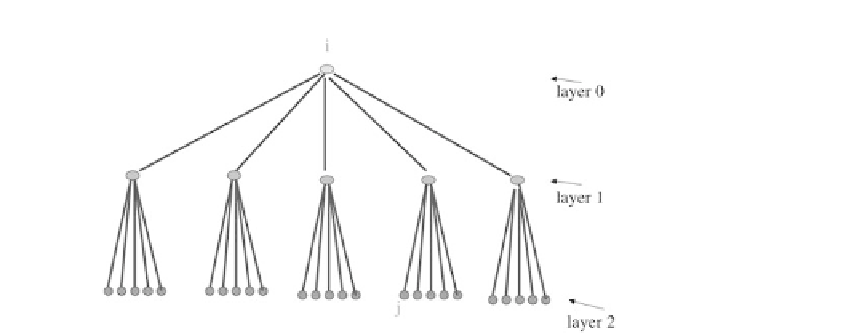Information Technology Reference
In-Depth Information
Figure 6.10.
This figure illustrates the small-world concept. In spite of the fact that the node denoted by
j
is a
unit of a very large population, it is located at a distance
l
=
2 from the node denoted by
i
.
Let us now make the assumption that
l
is sufficiently large as to ensure that all of the
nodes are connected,
N
l
≈
N
.Wehave
z
l
N
=
,
(6.75)
where
l
defines the network length.
Note that (
6.75
) is an approximation, or rather an estimate, of the number of nodes
necessary to characterize the length of the web, because in the earlier layers there are
points that we are not counting. To convince the reader that the error corresponding to
this approximation is small, consider the quantity
R
defined by
z
l
−
1
z
l
−
2
+
+···+
z
1
z
+···
1
z
l
−
2
+
1
z
l
−
1
.
R
=
=
(6.76)
z
l
This quantity is the ratio of the neglected population to the total population. The
condition
z
1 yields
1
z
R
≈
1
.
(6.77)
If the total population is
N
=
300
,
000
,
000, namely the population of the United States,
26, that is, 26
6
10
8
and the
corresponding to the sixth layer
l
=
6, we have
z
≈
≈
3
×
population of the fifth layer is about 12
000 people.
In summary, we can use (
6.75
) to define the length of the network, thereby obtaining
,
000
,
ln
N
ln
z
.
l
=
(6.78)
Owing to the logarithmic dependence on
N
, we reach the conclusion that the length of
even a random web is small. Consequently, we live in a small world.
The clustering coefficient
Let us now study another important property of random webs:
the clustering coefficient
.
This coefficient is also of value in the general setting of complex networks. Let us
consider a generic node P and assume that the node P in Figure
6.11
is linked to two


